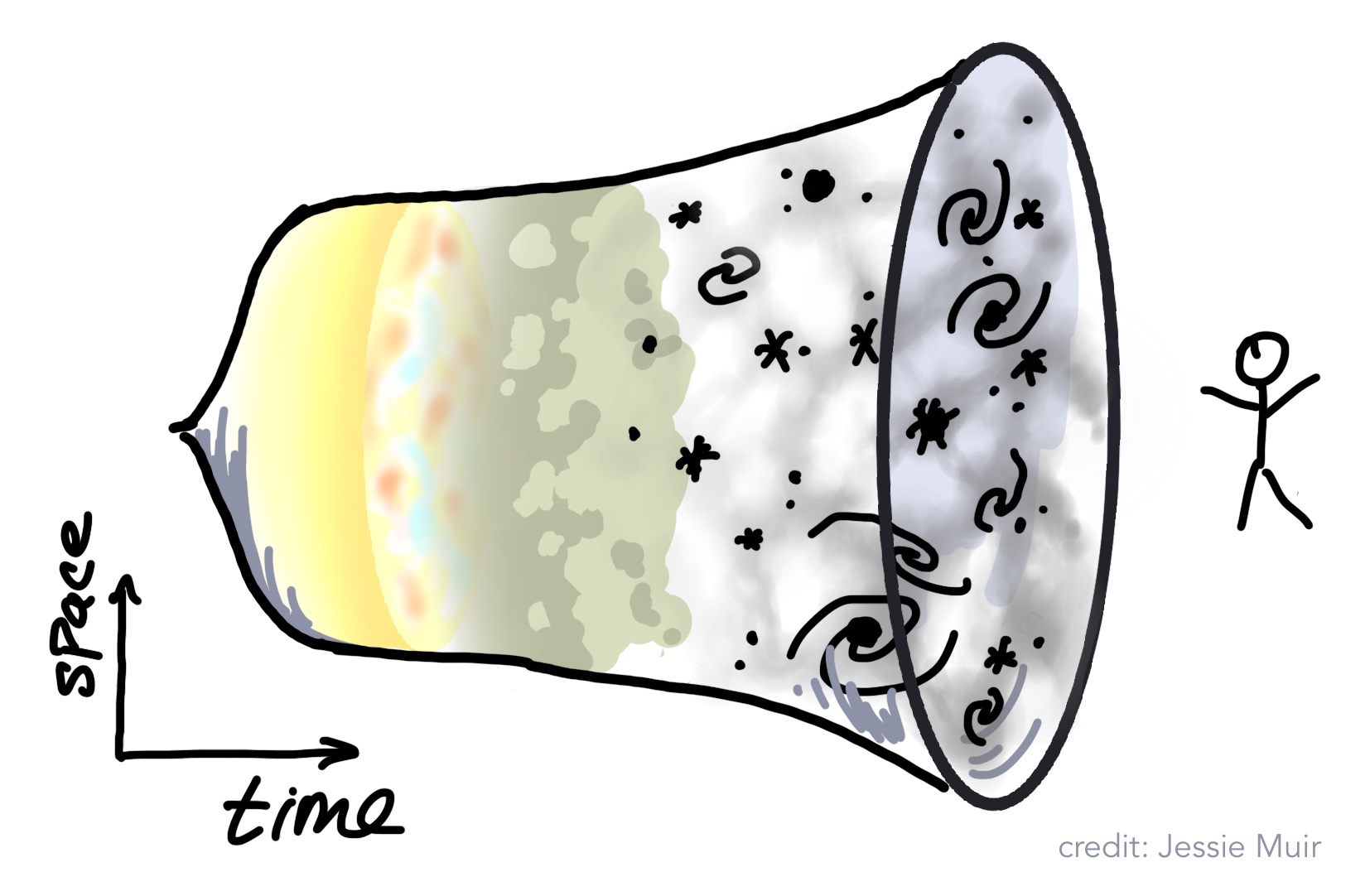A list of my publications can be found on this ADS bibliography.
Current & recent projects
-
Validating and improving modeling tools for beyond-LCDM cosmology - Many of the calculations and software used to model galaxy survey observables have been developed and validated under the assumptions of the standard cosmological model, LCDM. Motivated by my work on beyond-LCDM science for the Dark Energy Survey (described below) I’m working on several projects assessing whether and how these tools can be applied to extended cosmological model analyses, as well as seeking ways of improving them. My ongoing projects include studies concerned with spatial curvature and with light relic sterile neutrinos, but I’m broadly interested in efforts to tetst beyond-LCDM cosmology and, in particular, in conducting tests for non-standard large-scale structure growth.
-
Probes of large scale structure beyond two-point correlations - Most analyses of the distribution of matter and galaxies in the Universe capture statistical information about structure using two-point summary statistics like power spectra and angular correlation functions. I’m interested in examining how we can extract more physical information from large scale structure by making use of higher order statistics, and in addressing challenges necessary to take newly proposed summary statistics from promising proofs-of-concept to robust experimental constraints. As an introduction to this topic, I’m working on a project studying the nearest neighbor distributions statistic proposed by Arka Banerjee and Tom Abel as a probe of modified gravity.
-
DES Year 3 theory and combined probes, extended cosmological models - (beyond-LCDM paper)(LCDM paper) - The Dark Energy Survey (DES) is an ongoing project to map the distribution of matter in the Universe using measurements of galaxy shapes and positions over 1/8th of the sky, and to use that survey to place constraints on the properties of dark energy and other aspects of our cosmological model. I’ve contributed in a variety of ways to the modeling infrastructure and analysis for the DES Year 1, Year 3, and ongoing Year 6 cosmology analyses. Most significantly, with Agnes Ferte (SLAC), I co-led the DES Y3 galaxy clustering and weak lensing analysis of models beyond-ΛCDM. In that work we studied time-dependent dark energy, sterile neutrinos, modified gravity, non-zero curvature, and a non-parametric measurement of large scale structure growth.
-
Protecting multi-probe cosmology analyses from experimenter bias - (paper) - As cosmological experiments grow increasingly precise, it is important to protect their results from a variety of systematic biases, including those that experimenters might unconsciously introduce. Blind analysis is a framework of experimental design in which data are manipulated to conceal an analysis’ true results until all decisions about how to conduct it are finalized. I led the implementation and testing for a new, generally applicable blinding method that works by transforming the summary statistics that are inputs for parameter estimation (for DES, these are galaxy clustering and shear two-point angularcorrelation functions). This method was used in the the DES Year 3 combined analysis of galaxy clustering and weak lensing, will be applied as part of Rubin Observatory LSST DESC cosmology analyses.
-
Growth-geometry split analysis of DES data - (paper) - Many models of modified gravity can produce the same expansion history as LCDM, the standard cosmological model of a cosmological constant + cold dark matter + general relativity, but will differ in their predictions for the evolution of large scale structure growth. The idea of a grow-geometry split analysis is to separately constrain cosmological parameters using measurements of expansion and structure growth, and then to test the consistency of those constraints. I performed a growth geometry split analysis of DES Year 1 data. I’m also generally interested in using galaxy survey data to test for modified gravity via phenomenological parameterizations of deviations from general relativity.
-
CMB anomaly covariances - (paper) - For the most part, data from the cosmic microwave background (CMB) have been found to be in remarkable agreement with the predictions of the standard cosmological model. However, there are a handful of features on very large angular scales which have been the subject of much study because they are statistically unlikely in ΛCDM. I used large ensembles of simulated CMB maps to characterize the extent to which these various anomalies are independent.
-
ISW signal reconstruction - (paper 1)(paper 2) - When CMB photons pass through large scale structure, their energy gets modulated by the time evolution of the associated gravitational potential fluctuations. This modulation, known as the integrated Sachs-Wolfe (ISW) effect, contributes to CMB temperature anisotropies at large angular scales. Because galaxies trace the same overdensities that source the ISW effect, we can construct an estimator of the ISW signal based on galaxy survey maps of cosmological structures. In the two linked two papers I explored how different survey properties and systematics affecting the input galaxy maps impact the accuracy of this estimator.
-
Astrophysical black holes and modified gravity - (paper) - For a master’s project, I did an exploratory study of how the infall of objects into black holes would be affected by a class of extensions to general relativity in which a new gravitational field interacts with matter in the black hole’s accretion disk.
Other activities
Though I can’t really claim it as a project, I was lucky enough to be on observing shift during the tail end of the DES follow-up observations of the binary neutron star collision detected by LIGO in August 2017. Data I took played a small role in these three papers.
